Air Soay – flying the friendly sheep to new owners
When last we met, I promised to discuss the logistics of shipping Soay sheep cross-country and share with you the personal satisfaction of working with the recipients of the airborne sheep to make it happen. Business first and then the human side of things.
You probably will not be surprised to learn that air-shipping Soay sheep these days is much more complicated than it used to be, when a breeder could just show up at the airport with an animal in a crate, buy the ticket, and go home. Nowadays the paperwork, equipment, and timing are sufficiently complex to deter all but bull-headed or foolhardy breeders — like us — unless there is good reason, as there was for us this year.
Paperwork. Livestock breeders who ship animals interstate are familiar with the 30-day health certificate required in almost all states. That same health certificate is required for air travel, but it is valid for only 10 days. Additional required documentation gets filled out either over the phone with the cargo agents, or at airport check-in. You will need the predictable information about your animal — full name, gender, age, vaccination records, scrapie tag, name address and telephone number of the buyer — at hand both when you make the reservation and when you arrive at the airport. Each major airline has a separate cargo division, and these are the folks you need to find first in order to learn their current rules and to make the reservation itself.
Assemble Team Soay. Ask the cargo staff at the airline’s 800 number to put you in touch with a real person at both your airport and the receiving airport so you can confirm everything the cargo division people tell you and make sure everyone is on the same page. For example, you want to be sure the sheep will not be stranded at the receiving airport because the plane arrived at 10:00pm but the cargo office at that particular airport has an earlier closing time. Every airport has quirks in its procedures and policies and the people on the ground at each airport need to be your new best friends.
Equipment. Each airline and each airport also has its own crate size requirements and they sometimes do not match the generalized statements on the airline’s website for cargo. For example, most planes flying out of our small airport (Medford) are a particular brand of regional jet whose engines encroach on the cargo opening and severely narrow the choice of otherwise acceptable crate sizes. If I had not talked to the person here in Medford, we would have showed up with two rams — one going to Pittsburgh and the other to Albany — in the “large” crates we were told by the 800 number (and the website) to buy, but which do not fit on our regional jets.
Airline crates large enough to hold a standing Soay sheep and small enough to fit the airlines’ size restrictions cost between $45 and $70 (variously called “intermediate” or “large”), plus the packet of labels and a water holder that clips on the side of the crate. No self-respecting Soay sheep will drink out of this holder, but it does not matter. You are required to have one and the animal will not hurt itself if it knocks the holder off its moorings.
Timing. The 10-day limit on the health certificate would not be a problem if it were not also the case that the airlines available to us (United and Delta) will not take animal reservations more than 7 days in advance, which makes for a tight window when you factor in both parties’ schedules. Everyone needs to exercise a lot of flexibility to make it work.
Another time constraint applies whenever one of the parties lives in a small community and the shipment is cross-country. It takes three flights for us or one of our sheep to get anywhere east of Chicago, and the time change works against us because most cargo departments close by 9:00 or 10:00 at night, leaving no one to accept arriving animals after that. The animal will be en route for a minimum of 8 hours with two plane changes. That may sound like too much stress, but in fact it compares favorably with cross-country truck shipment. On a truck, a cross-country trip takes at least several days, assuming the trucker makes the stops required to keep the animals watered and their rumens operating. With air travel, the animal arrives the same day it leaves the seller’s farm, so the animals do not undergo the unavoidable stresses of multi-day travel.
We initially thought it was ridiculous when Delta demanded we arrive two hours early, but despite all our advance planning, the paperwork at check-in, including “luggage” tags for the crates, took about 45 minutes, so we were glad we heeded the airline’s caution.
More advantages to flying sheep. Other than the possibility of one or two unknown animals on the plane with your animal, you avoid the contamination issues inherent in shipping on a truck full of other people’s animals. For one animal going all the way across the country, flying was cheaper for our buyers than hiring a livestock truck hauler.
The downsides. The disadvantages to air travel mirror the advantages. The risk of lost “luggage” is the big downside. There is no group discount or low “second and third” animal charges as there typically are on trucks. Each animal is treated as a separate shipment, so shipping more than one animal will quickly turn the cost advantage upside down. Roughly speaking, two animals probably can be air-shipped more cheaply than a cross-country truck, but that’s about it.
For us, and we suspect it would be for all sheep farmers, the other big disadvantages are the timing issues and the delivery of the animal to the airport. In order to get the sheep to their new homes the same day, we have to book flights leaving our airport at 6:00 am, which means arriving for check-in at 4:00 am (by airline fiat), which means getting up at 2:30 to load the animals, grab a cup of coffee, and be on the road by 3:15am. Yawn.
Air Soay can be fun. When we shipped earlier this fall, the entire airport midnight shift was on hand to greet our two rams. Apparently, when the rams’ paperwork arrived from Delta Cargo Corporate the day before, word got around that an unusual animal shipment was arriving that night. To be sure, we often found ourselves saying “no, not goats, they are sheep” during the check-in process. Nonetheless, the curiosity and enthusiasm of the airline employees and some of the passengers in line made for a more interesting check-in experience than we normally encounter when we leave the farm for “back east” visits. For those of us who love these little sheep, showing them off in an unusual venue is just plain fun.
In the final analysis, what made the whole process a grand adventure rather than merely a burdensome human cost of doing business was the story associated with each ram.
Our Albany-based customers have a handsome flock of brown and tan and mahogany Soay sheep, but they wanted a black ram so they can play with more color genetics in their flock. Here is little Blue Ribbon sporting his color-coded horn tape just before he left for his new home.
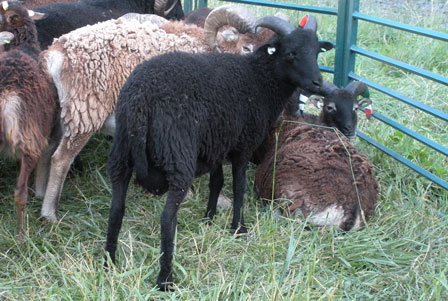
As living proof that sheep are none the worse for having flown Air Soay, here is Blue Ribbon in his new home, right in the thick of things vying for the yummiest blackberry vine with Melissa tempting her handsome tan and brown — and now black — Soay rams:
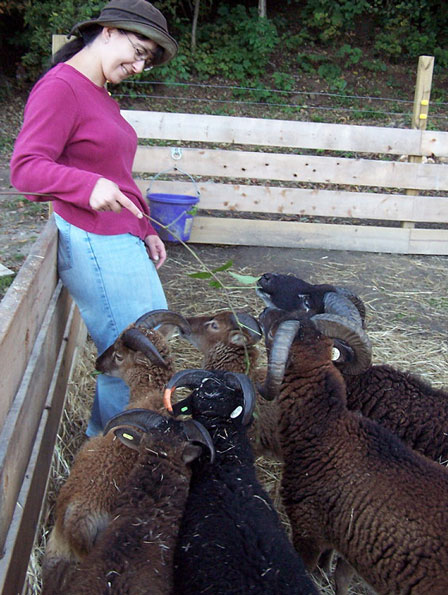
The other ram we shipped, as some of you may remember, was a surprise birthday present. For us, acting as co-conspirators to make the surprise work was one of the most rewarding adventures we have had with our flock. Let me set the stage.
Last July, we were minding our own business in the relative tranquility of summer, having never seriously entertained the notion of shipping a Soay sheep by air, when across the wires came the following e-mail:
I hope you will forgive me for e-mailing on my work account but I’m thinking of trying to surprise Candy for her birthday. It would be wonderful if I could get a new Soay ram here by the end of September. What British Soay do you have available that are genetically suitable for adding to our small flock? Do you think it’s feasible to get all this done including transportation (flying?) by September 28th? I hope you might be able to help me pull this off. Regards, Stuart
Who could resist this plea? I certainly could not; I thrive on organizational challenges. And thus began the six-week scramble to identify a ram lamb with different genetics than the east coast flocks of British Soay, pin down flight arrangements, run the schedule-balancing act, and accomplish the whole thing without spoiling the surprise by accidentally e-mailing or calling Stuart at home.
In the process, we not only learned how to ship Soay sheep, but more importantly, a handsome little ram, Saltmarsh Borwick, is now providing genetic diversity to a faraway flock — a gift that will keep on giving. We even got a history lesson from Stuart, himself British, about the little town in Lancashire for which Borwick is named:
Dear Priscilla and Steve, Borwick is an historic village and civil parish, first mentioned in the Doomsday Book. It is situated on the Lancashire/Cumbria border, about 8 miles north of Lancaster, on the Lancaster Canal. The civil parish also encompasses the hamlet of Tewitfield. According to the 2001 census, population of 210. Borwick is a perfect base from which to explore the Lake District, the Yorkshire Dales and the coastal areas of Arnside and Silverdale, designated areas of outstanding natural beauty. The scenic Lancaster Canal runs through the village.
I don’t know about you, but I am ready to call British Airways and book my flight!
Here is master Borwick sporting his yellow and orange identifying horn tape, also about ready for his trip east. Doesn’t he look like the proper young Brit about to depart for boarding school?
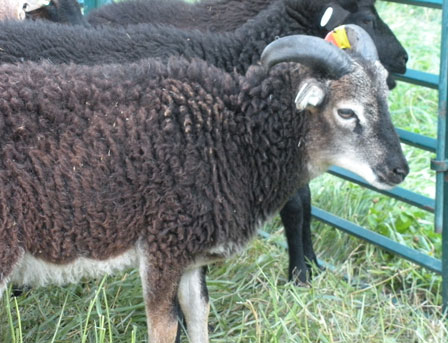
The caption on this picture of Borwick as he arrived in Pittsburgh tells it all: “first glimpse!”
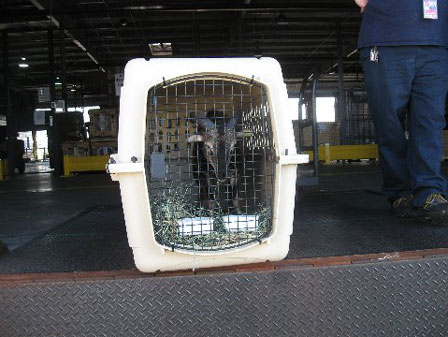
Pop quiz. Is Candy happy with her new ram?
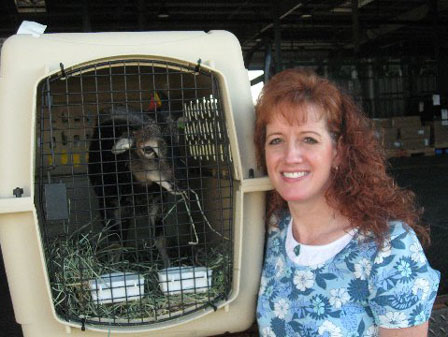
But not so fast. Look who’s monopolizing Borwick right out of the crate. Whose birthday was it, anyway?
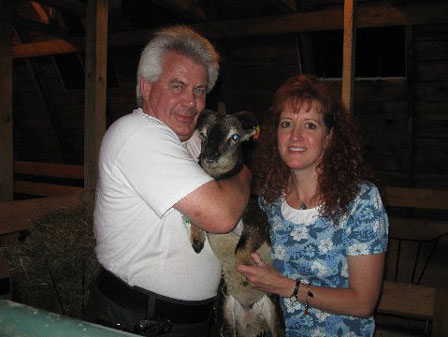
And as if the pictures of the proud new owners were not enough thanks, a few weeks later a package arrived with matching Soay sheep sweatshirts for Steve and me — handstitched by Candy when she was not busy out admiring Borwick and her ewes. Is this a great thank you gift or what?
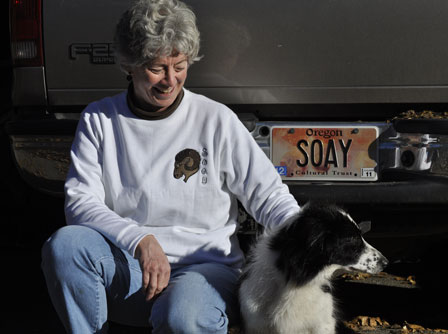
If you are thinking about shipping Soay sheep by air, take a deep breath, take good notes, and take the leap. It can be a great way to help diversify the North American-based Soay sheep population.
For now …